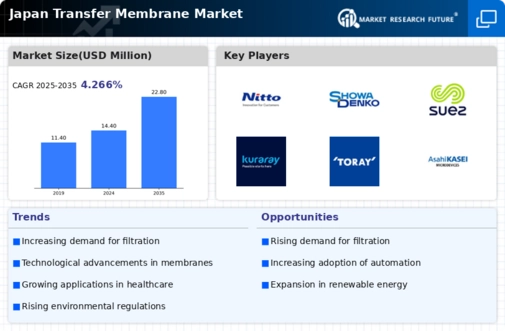Rising Demand in Biotechnology
The transfer membrane market in Japan is experiencing a notable surge in demand, particularly within the biotechnology sector. This growth is largely attributed to the increasing need for efficient separation and purification processes in biopharmaceutical production. As the biopharmaceutical industry expands, driven by innovations in drug development and personalized medicine, the requirement for high-quality transfer membranes becomes critical. In 2025, the market for biopharmaceuticals in Japan is projected to reach approximately $20 billion, indicating a robust growth trajectory. Consequently, the transfer membrane market is poised to benefit significantly from this trend, as manufacturers seek advanced membrane technologies to enhance productivity and ensure compliance with stringent quality standards.
Expansion of Water Treatment Facilities
Japan's commitment to environmental sustainability and water resource management is propelling the expansion of water treatment facilities across the nation. This trend is expected to have a profound impact on the transfer membrane market, as advanced membrane technologies are essential for effective water purification and desalination processes. The Japanese government has allocated substantial funding, estimated at $1 billion, for the development of innovative water treatment solutions. As a result, the demand for transfer membranes, particularly those designed for reverse osmosis and ultrafiltration applications, is likely to increase. This growth reflects a broader recognition of the importance of clean water access and environmental protection, positioning the transfer membrane market favorably for future investments.
Emergence of Advanced Membrane Technologies
The transfer membrane market in Japan is witnessing the emergence of advanced membrane technologies that promise to revolutionize various applications. Innovations such as nanofiltration and membrane bioreactors are gaining traction, driven by the need for more efficient and sustainable solutions. These technologies offer improved performance in terms of selectivity and energy efficiency, which are critical factors for industries such as food and beverage, pharmaceuticals, and wastewater treatment. As companies increasingly prioritize sustainability and operational efficiency, the demand for these advanced membranes is expected to rise. This trend suggests that the transfer membrane market is on the cusp of significant transformation, with potential for growth as new technologies are developed and adopted.
Growing Pharmaceutical Manufacturing Sector
The pharmaceutical manufacturing sector in Japan is experiencing robust growth, which is significantly influencing the transfer membrane market. With the increasing production of biologics and biosimilars, there is a rising demand for efficient filtration and separation technologies. The market for pharmaceutical manufacturing in Japan is projected to exceed $50 billion by 2025, creating substantial opportunities for transfer membrane applications. Manufacturers are increasingly adopting advanced membrane technologies to enhance process efficiency and product quality. This trend indicates that the transfer membrane market is well-positioned to capitalize on the expanding pharmaceutical landscape, as companies seek to optimize their production processes and ensure compliance with regulatory standards.
Increased Focus on Research and Development
The transfer membrane market in Japan is witnessing a heightened emphasis on research and development (R&D) activities. This focus is driven by the need for innovative membrane technologies that can meet the evolving demands of various applications, including pharmaceuticals, food processing, and environmental monitoring. Japanese companies are investing heavily in R&D, with expenditures reaching approximately $5 billion in 2025. This investment is aimed at developing membranes with enhanced performance characteristics, such as higher selectivity and improved fouling resistance. As a result, the transfer membrane market is likely to see the introduction of advanced products that cater to specific industry needs, thereby fostering competitive advantages for manufacturers.

















Leave a Comment